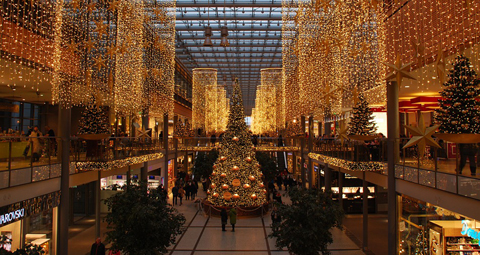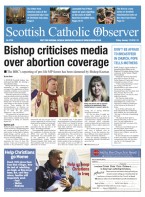January 12 | ![]() 0 COMMENTS
0 COMMENTS ![]() print
print

Christmas consumerism is exposed by Christ’s light
BRANDON MCGINLEY’s letter from America focuses on materialism
Winter is thought to be the season of darkness, but it’s a little more complicated than that. There is in fact no noontime brighter than a January noontime, with no foliage to absorb the sunshine that comes both from above and from below, as the light reflects off snow and ice. Even when the weather is mild, a crisp winter afternoon is brighter than a hazy summer one.
Winter, therefore, is the season of chiaroscuro—of the lightest lights and the darkest darks, and of the tension and the drama and, sometimes, the clarity that come with contrast. How perfectly appropriate it is that Christmas comes during this time of the year.
Of course, there is the light of the Christ Child who shines in the darkness of the manger and of a world without salvation. At the end of the classic American television special The Little Drummer Boy, our four-year-old daughter asked: “Why is Baby Jesus glowing?”
I don’t know what I said in the fog of Christmas exhaustion, but I should have said: “Because He is the light of the world, and He shines especially brightly where the world is the darkest.”
The season of contrasts manifests itself in countless ways, many of which relate to the distinction between the Christmas of the Church and the Christmas of our culture.
My wife and I made a rare trip to a large suburban mall on the Friday before Christmas, and naturally it was all decorated in attractive garlands and lights. But this ornamentation was ordered not to celebrate the Nativity but to creating an environment that encouraged unnecessary seasonal spending, and amid all the contrived festive cheer, nearly every customer and clerk we saw appeared to be utterly miserable.
Family differences are thrown into sharper relief during the Christmas season, as people with different understandings and expectations for the season come together.
When so many celebrate the holiday primarily as a secular gift-giving bonanza, bringing either the extravagant joy of the Incarnation or a staid detachment from consumerism to the table can be uncomfortable for everyone. And there’s no way around it; there’s no neutral way to celebrate the birth of the Saviour.
Chiaroscuro, which comes into English from the Italian words for ‘light’ and ‘dark,’ developed as a way for painters to make their subjects appear more solid and vivid by making light seem to fall on them at sharp angles, dropping shadows on every facial wrinkle and fold of fabric.
While some subtlety might be lost in the darkness (or in the light), the overall effect is to make reality more clearly visible.
And so it is this time of year. That uneasiness you feel when the idea of ‘Christmas’ is used by corporations to encourage excess consumption? That twinge you notice when a friend or family member speaks about Christmas church services as annoying or even expendable impositions? That suspicion you can’t escape that the Nativity of Our Lord is utterly irrelevant to most people and institutions in this culture, except in as much as it can be leveraged to profit or some other advantage?
Well, that is the reality that our seasonal chiaroscuro exposes.
And so we would do well to notice these same phenomena of secularisation even when they aren’t so obvious, and to recognise that there can be no lasting accord between the Faith of Jesus Christ and the creed of secular materialism.
If you’re offended that some shops maintain ridiculous hours around Christmas, consider whether they should be open on Sundays at all.
If some people have come to think that Christmas Mass is superfluous, perhaps we could all be less blithe about the beauty of the weekly obligation throughout the year. If you think Christmas is being exploited by moneyed interests, consider how powerful people and institutions—especially those you want to trust—exploit Jesus Christ all year long.
Christmas proper is now over, but winter continues. Let us regard the harsh light and sombre darkness of this season with confidence that whatever contradictions are laid bare between our Faith and our culture should be embraced rather than ignored.
The Light of Christ can be soft and comforting, but it can also be frighteningly revealing—and purifying. Let us not bury it under a bushel basket out of fear of what it will illuminate.











